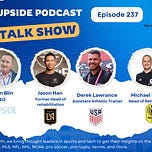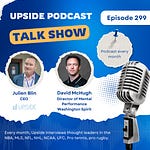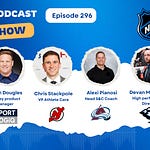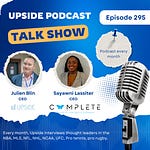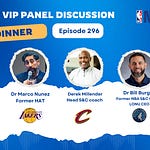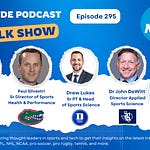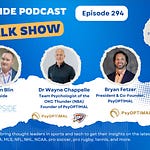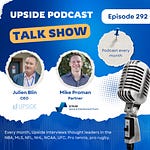This week we have the honor to interview again a group of sports performance executives to talk about the latest trends in the world of sports performance and rehabilitation.
Jason Han, the former head of rehabilitation at LAFC (MLS). Jason is also the head of business development in North America at OneBase health.
Michael Messer, the head of rehabilitation at Nashville SC (MLS).
Chris Wolbert, the director of rehabilitation at Sporting KC (MLS).
Derek Lawrance, the Assistant Athletic trainer of the U.S. Men’s Soccer National soccer team.
📝Show Notes: Through this interview, we touched on:
How advances in sports science changed the way teams approach training and load management.
The notable trends in common injuries in professional soccer, and how teams are addressing them.
The most common sleep-related issues among professional soccer players, and how teams are addressing them.
Experimental cutting-edge rehab techniques that teams are testing right now.
How teams are preparing for these conditions extreme heat expected at the 2026 World Cup and if there are adjustments being made to training schedules, hydration strategies, or match-day protocols.
You can read the full transcript of the podcast interview located at the top of this blog post.
Here are some of the best quotes of our conversation with Michael, Derek, Chris, and Jason:
Q1: How have advances in sports science changed the way teams approach training and load management?
Mike Messer (Nashville SC):
“Load management has always been part of training, but the evolution of sports science has made it more precise. Now we’re able to quantify load from multiple angles—volume, intensity, change of direction—using GPS, heart rate, even technical data. It allows us to build sessions that mirror match demands and return-to-play goals more accurately. Earlier in my career, I had to rely on session RPE and duration alone. Now, with all these tools, our decision-making is more refined, and the athlete’s transition back to performance is better supported.”
Jason Han (formerly LAFC):
“It’s become a blend of art and science. The numbers help, but you still have to read the athlete, know their baseline, their body language, even their personality. What an RPE of 8 means for one guy might be a 5 for another. When we started getting internal and external load data in MLS, it allowed us to be more strategic with training and rehab. But it doesn’t replace experience or intuition—it complements it. That human piece is just as important as the technology.”
Chris Wolbert (Sporting KC):
“The data is only as useful as the environment you’re in. If the head coach doesn’t buy in, it doesn’t matter how sophisticated your systems are. Fortunately, I’ve worked with coaches like Peter Vermes and now Kerry who understand the value of data and apply it within their philosophy. It creates alignment across departments. That alignment is where sports science can really thrive and influence daily decision-making, especially around training loads and return-to-play progression.”
Q2: Have there been notable trends in common injuries in pro soccer, and how are teams addressing them?
Chris Wolbert:
“We’re still seeing familiar injuries—hamstrings, groins, quads, calves—but the severity of those soft tissue injuries has increased. We’re also seeing more cartilage issues than before. Part of that is due to how fast and powerful today’s players are. The body’s under more load, more often, and that cumulative stress shows up in injury data. That’s where load monitoring and recovery strategies become even more essential.”
Jason Han:
“The packed schedule is a big factor. The body only has so much capacity. Even if you load manage perfectly, the reality is, the schedule is what it is. So we zoom out—look at the whole chain, not just the injured muscle. A hamstring issue might be related to hip stiffness or something contralateral. And we’re integrating regenerative modalities—shockwave, EMTT, hyperbaric oxygen therapy. These show potential, but they need more research, especially in elite, high-load settings like ours.”
Derek Lawrance:
“What’s interesting is, even with all the investment in hamstring prevention, those injuries are still climbing. That says a lot. The context keeps shifting—MLS added more games, more competitions, longer playoffs. Players are being asked to do more, and we’re constantly reacting to new demands. It’s hard to stay ahead when the workload grows every season. We’re solving yesterday’s problems while trying to meet today’s realities.”
Q3: What are the most common sleep-related issues among pro soccer players, and how are teams addressing them?
Chris Wolbert:
“Post-game sleep is the most common issue. Almost every player struggles to sleep after a night game. They’re wired from the adrenaline, or sometimes stimulants. Melatonin and sleep aids are common, but a lot of guys try to ‘make up’ for it with long naps the next day. That throws off their circadian rhythm even more. Our role is to educate them—keep naps short, manage caffeine, understand how sleep architecture works. It’s about small habits that make a big difference.”
Derek Lawrance:
“People always point to adrenaline, but the unspoken factor is caffeine. Guys take caffeine pills or energy drinks right before games—200 mg at 7 or 8 PM—and then they wonder why they’re staring at the ceiling at 3 AM. Everyone metabolizes caffeine differently, so the stimulation lasts longer for some than others. That messes up sleep, and if they’re in the facility for recovery the next morning, they’re doing it on 3 hours of rest. It’s a cycle we’re trying to break with better planning and education.”
Michael Messer:
“We’ve been exploring whether we should shift training later the day after a game or adjust off days to help guys recover better. But it’s not simple. Some players didn’t even play, some have kids waking them up early, others went out to blow off steam. Everyone’s schedule and lifestyle are different. Sleep recovery, like load management, has to be individualized. There’s no one-size-fits-all approach.”
Q4: Are there any experimental or cutting-edge rehab techniques that teams are testing right now?
Chris Wolbert:
“I’m exploring virtual and augmented reality applications in rehab. The idea is to simulate tactical scenarios and decision-making for players in long-term recovery, keeping their mental sharpness intact. It’s still early, and I haven’t implemented it yet, but there’s some interesting early feedback from the UK. I think it could become part of holistic recovery in the near future.”
Jason Han:
“I’ve been using EMTT—Extra Corporeal Magnetotransduction Therapy—and combining it with shockwave therapy. It’s non-invasive and powerful. When done correctly, studies suggest it boosts healing outcomes by 15 to 25 percent. For chronic conditions or cases where we want to avoid injections or surgery, it’s a promising tool. In elite sport, where recovery time is everything, it offers another layer to our toolkit.”
Michael Messer:
“One thing I’ve been trying is using Catapult’s change of direction metrics—specifically IMA data—to detect imbalances during rehab. For example, if an athlete cuts more aggressively to one side post-injury, that asymmetry shows up in the data. It’s a way to ‘invisibly’ monitor tissue recovery in real-time without pulling them from a session. That kind of feedback helps us refine the rehab and track readiness to return.”
Q5: With extreme heat expected at the 2026 World Cup, how are teams preparing? Are there changes to training schedules, hydration strategies, or match-day protocols?
Derek Lawrance:
“A lot of the games will be in climate-controlled stadiums, but that doesn’t eliminate the need to prepare. In Qatar, we trained in 90+ degrees to help players acclimate. Hydration breaks were frequent, and we shifted our entire schedule to match 10 PM kickoff times. Managing circadian rhythm, load, and hydration all at once becomes the puzzle. You can’t just avoid the heat—you need a strategy to adapt to it before the tournament starts.”
Michael Messer:
“In MLS, we don’t get a buildup. If Seattle flies to Orlando for a game, you’ve got one or two days to adapt. So hydration and cooling strategies are key. We use individualized sweat profiles to tailor hydration plans, and we’ve looked into newer cooling devices like AVA, which cools the extremities quickly and helps regulate body temp faster than towels or ice alone. It’s about being prepared, even when conditions change game to game.”
Jason Han:
“Hydration starts with education. We used systems like Intake Health that gave players instant feedback on hydration status—if they were in the red or green. It became a talking point. Some players are stubborn—they’ll drink mate all day and think they’re fine. But once you show them the data, it creates buy-in. If they’re professionals, they’ll respond to information that helps them perform better.”
You may also like:
🔥Upside Chat with Mike Messer (Nashville SC / MLS), Rick Cost (US Soccer), Jason Han (Ex LAFC / MLS)
This week we have the honor to interview again a group of sports performance executives to talk about the latest trends in the world of sports performance and rehabilitation.
🔥Upside Chat with Andrea Hudy (UCONN/NCAA), Drew Lukes (Duke University/NCAA), Michael Messer (Nashville SC/MLS) on Commonalities & Differences Between the NCAA & MLS.
This week we had the honor to interview again a group of sports performance experts.

